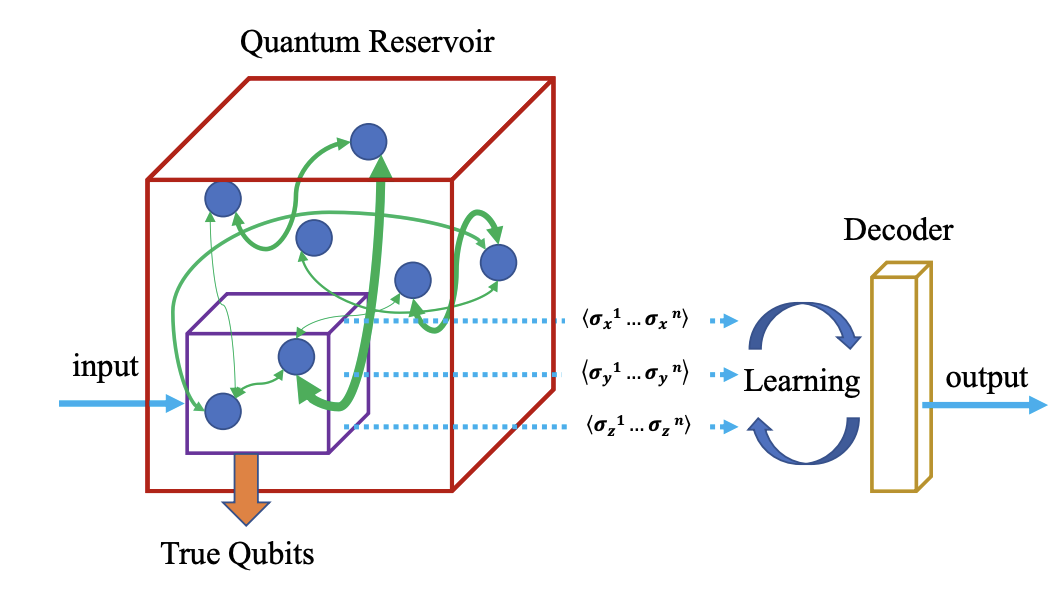Quantum Reservoir Computing (QRC) is a new field that merges quantum physics and machine learning. It uses a high-dimensional dynamical structure known as a reservoir, which is ideal for tasks requiring memory-retention capabilities. QRC introduces quantum features like superposition and entanglement to reservoir computing. Two QRC models have been proposed, one based on networks of qubits and another on oscillator-based reservoirs. Noise in quantum devices can affect QRC, but under certain conditions, it can enhance its efficacy. Quantum entanglement’s role in QRC depends on the frequency of the input signal. QRC could potentially improve machine learning models, but more research is needed.
What is Quantum Reservoir Computing and How Does it Work?
Quantum Reservoir Computing (QRC) is a relatively new field that combines the principles of quantum physics with machine learning. The concept of reservoir computing (RC) is a powerful mechanism in machine learning, characterized by a high-dimensional dynamical structure known as a reservoir. This system, upon receiving streams of input, engenders transient dynamics featuring a fading memory capacity and the ability to perform nonlinear processing on input data. The complex internal dynamics of the reservoir render RC exceptionally well-suited for machine learning tasks that demand memory-retention capabilities such as speech recognition, stock market prediction, and autonomous motor control for robots.
Traditional approaches to RC have been based on either randomly-connected artificial neural networks or through spiking neural networks. Physical implementations of RC have been realized with photonics, phonons, magnons, spintronics, and nanomaterials structured in neuromorphic chips. QRC introduces to RC such counter-intuitive features of quantum physics as superposition and entanglement. Two distinct QRC models have been proposed, one is grounded in networks of qubits and another in oscillator-based reservoirs.
In the qubit-based model, transitions of basis states for quantum bits (qubits) are propelled by an input stream, evolving over time through the reservoir’s quantum dynamics. Input data is fed into the true nodes, typically in the form of a time series. For the readout, besides these true nodes, hidden nodes can also be used which influence the time evolution of the true nodes.
How Does Noise Affect Quantum Reservoir Computing?
The primary obstacle encountered by quantum computing and quantum machine learning is the noise present in quantum devices. Significant efforts have been dedicated to correcting or mitigating the resulting errors. Recent studies show that the presence of noise can improve the convergence of variational quantum algorithms. Further, it is suggested that quantum noise under specific conditions can enhance the efficacy of quantum reservoir computing.
For time-series data, the frequency and the stochasticity of the data play crucial roles in the performance of machine learning models. Times-series data, characterized by its sequential order, can vary in frequency from high-resolution milliseconds to monthly or yearly observations. On the other hand, studies suggest potential advantages of quantum computing in systems characterized by high levels of stochasticity and randomness, though these advantages are not always measured against the most optimized classical solutions.
What is the Role of Quantum Entanglement in Quantum Reservoir Computing?
The study conducted by Youssef Kora, Hadi Zadeh Haghighi, Terrence C Stewart, Khabat Heshami, and Christoph Simon investigates the performance of an Ising spin network for QRC in linear and nonlinear memory tasks. They monitor the behavior of quantum entanglement, which they quantify by means of the partial transpose of the density matrix. In the most general case where the effects of dissipation are incorporated, their results indicate that the strength of the entanglement advantage depends on the frequency of the input signal. The benefit of entanglement is greater the more rapidly fluctuating the signal, whereas a low-frequency input lends itself better to a non-entangled reservoir. This suggests that the extent to which quantumness is beneficial is dependent on the difficulty of the memory task.
How Can Quantum Reservoir Computing Improve Machine Learning Models?
Experimental evidence tentatively indicates that quantum approaches to simulating stochastic processes might require less memory than traditional classical methods under certain conditions. Preliminary findings propose that by negotiating the tradeoff between accuracy and memory usage, quantum models could potentially achieve comparable levels of accuracy with reduced memory requirements or conversely improve accuracy without increasing the memory footprint. However, these observations are context-dependent and should be considered with caution.
In conclusion, Quantum Reservoir Computing is a promising field that could potentially revolutionize the way we approach machine learning tasks. By leveraging the principles of quantum physics, QRC could potentially overcome some of the limitations of traditional machine learning models, such as the von Neumann bottleneck, and provide more efficient and accurate solutions. However, more research is needed to fully understand the potential benefits and challenges of this approach.
Publication details: “Frequency-dependent entanglement advantage in spin-network Quantum
Reservoir Computing”
Publication Date: 2024-03-13
Authors: Youssef Kora, Hadi Zadeh-Haghighi, Terrence C. Stewart, Khabat Heshami, et al.
Source: arXiv (Cornell University)
DOI: https://doi.org/10.48550/arxiv.2403.08998

